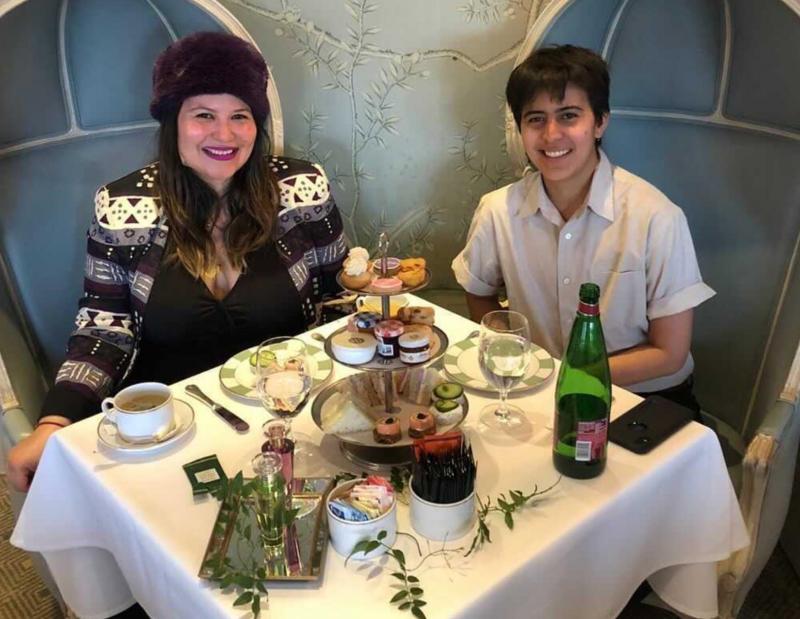Melissa Hago – a presenter at the recent World Tea Conference + Expo in Las Vegas, held June 28-30, 2021 – is vice president and creative director of Beauty & Wellness at Fashion Snoops.
At World Tea, Hago presented on “Tea Trends of the Future,” a well-attended session that was standing-room only.
Hago has been in the trend forecasting industry for more than 15 years. She launched the Beauty & Wellness section within Fashion Snoops in 2011, after seeing a need for specific beauty, wellness and food focused trend forecasting.
As an industry insider, she is constantly exposed to the latest innovations and trends, and she provides recommendations for product development and marketing.
Hago has traveled extensively to more than 50 countries, immersing herself in various global cultures and providing global coverage of events and tradeshows. In addition, she regularly provides beauty and wellness trend insight for numerous publications, and has been featured in Vogue UK, Harper’s Bazaar, Nylon, The Strategist and more.
World Tea News chats with Hago – in this enlightening Q&A – to glean insights and intel on trends.
Question: Tell us about your background and professional experience. How does it relate to the tea industry?
Answer: I’ve been in the trend forecasting industry for about 15 years. I originally started my career in fashion researching and forecasting, until 10 years ago when I attended a beauty trade show and thought the category as a whole would offer a great opportunity for our platform to speak to beauty trends. Since I launched the Beauty section within Fashion Snoops, the beauty industry has grown, most notably with wellness becoming more important as a topic, so we changed the focus from Beauty to Beauty & Wellness, in order to include a focus on food, tea, ingredients and other health-related trends.
As a tea lover myself, I felt the tea industry would also benefit from learning about the connection from lifestyle shifts to creating products. Tea itself is so interwoven with wellness, health, beauty and global culture, so it ties in to so many relevant discussions we’re having right now across categories.

Question: During your presentation at the 2021 World Tea Conference + Expo, you talked about tea trends during a packed, standing-room only educational session. What was your overall message to the tea industry during that session?
Answer: My overall message is that understanding how lifestyle and cultural shifts that are happening globally – from sustainability to technology to human rights – impact consumer purchases, making it incredibly important for the industry to understand what’s driving consumer behavior.
In my presentation, I explained the “why” behind what consumers are feeling. Everything is connected to a larger driver of behavior, and in order to create and market a successful product, it needs to resonate with consumers on some level: you can have the perfect product, but if it's not the right time or not targeted the right way, it can flop.
Question: What are some of the trends and innovations within the tea space right now, and what should members of the tea industry be paying attention to right now?
Answer: I spoke to five main trend themes at the show – restorative, wellness, soulcare, giving back, and feel good. If I had to choose, the ones that I think the industry should be particularly paying attention to and jumping on right now are giving back and soulcare.
For giving back, we are seeing consumers across industries become more socially engaged and activist-minded than ever before, and are seeking out tea brands that promote and support issues near to their heart – like inclusivity, ethical tea sourcing and sustainability. Authenticity is more important than ever, as consumers seek transparency on where their tea comes from and how it is harvested. There’s also a demand for more fair trade teas that support ethical treatment of workers, and see inclusivity becoming part of the conversation with Latinx- and Black-owned brands emerging and brands supporting the LGBTQ+ and AAPI communities.
Conversely, soulcare speaks to the growing new spiritualism movement that is deeply needed by consumers after the global pandemic trauma that we’ve all endured, and this trend encourages us to take care of our mind, body and soul through healing. Mindful teas emerge to connect the body and mind through our daily rituals, while teas inspired by wellness practices – such as yoga – speak to a deeper connection to the body.
Trends we see growing elsewhere – such as astrology and moon cycles – also develop into significant innovations within the tea world. Consumers are also intrigued by how the moon affects their bodies and spirits and seek to gain more wisdom through astrological focused and crystal-infused blends. The concept of self-care has evolved to encompass a more holistic approach, encompassing spirituality and an intuitive approach to the mind-body-spirit connection.

Question: What are some of the current or upcoming trends that relate to wellness that the tea industry should focus on?
Answer: Active lifestyles are on the rise, as the pandemic accelerated at-home fitness and a fitness-forward, a total-body approach to health, along with an overall heightened focus on immunity. Consumers embrace and are increasingly opting for products that help replenish them post-workout and boost their overall vitality. Supporting this shift are tea options that help restore balanced functioning, with nutrient-rich blends that boost immunity, or intriguing health properties like brain-boosting teas and gut-friendly probiotic options. As more consumers look to increase their water consumption, hydrating cold brew blends appeal for their light flavors that act as a healthy replacement for artificial sodas and juices, while workout-supporting teas enable smoother functioning for on-the-go consumers and new tea brands change the sugar-free conversation.
Aside from the active, healthy lifestyle movement, there is also a deep, overall need for balance and fulfillment, as consumers continue to strengthen the meaning of self-care through thoughtful tea blends. “Calm” remains the wellness word of the moment, as calm-inducing teas invite inner peace. Flowers are also big here, as tea trends mirror the larger slow flower movement, which creates therapeutic moments of learning and connection with nature through floral-infused blends. While beauty-boosting teas act as nutricosmetic drinks to help boost outer beauty from within.
Question: How are lifestyle shifts impacting consumer moods, and how should the tea industry respond to that in their marketing and sales efforts?
Answer: With stress and anxiety at an all-time high, consumers are looking for mood-boosting products and feel-good products that offer comfort and a dose of joy. I think making tea fun is important when marketing – with everything from create-your-own tea kits, to color-changing teas, making the experience of tea fun for consumers, which is much needed after such a stressful year.
We’re also seeing new, fun formats take hold that offer consumers a novel experience, from glittery blends to 3D printed shapes. The growing nostalgia trend also inspires new tea innovations, and pop culture icons are adorned onto packaging from Star Wars to Alice in Wonderland, while food-inspired tea launches infuse tea in a new way – from tea-infused candies to BBQ sauces.
Question: What important trends are you seeing in terms of flavors, ingredients, packaging, and health benefits that consumers are looking for in tea?
Well, certainly health and vitality are taking center stage post-pandemic as a prevailing consumer concern. Consumers are looking to tea to complement their lives and support their health now more than ever, with many consumers branching out in terms of their tea choices due to the effects of the pandemic.
Immune-boosting options or teas with health properties appeal for their ability to infuse consumers with nutrient-rich protection, and we’ve seen options like Greek mountain tea, which comes from trending “blue zones,” increase in popularity as consumers seek out healthy global lifestyles and natural botanicals to boost their wellbeing.
Adoptogens also continue to be a popular ingredient, helping to reduce stress and support brain function, which are two major consumer concerns at the moment, and we are also seeing probiotics and gut health teas emerge to help maintain balance and proper functioning. In addition, CBD, hemp, and psychedelics also make their way into tea products, as changing governmental and cultural standards see consumers become more curious and open-minded about exploring their potential health benefits.
Within packaging, I think sustainability is the top trend to watch, as tea brands strive to lower their environmental impact through processes like upcycling to contribute to a zero-waste tea industry. Post pandemic, we’re seeing many consumers actively seeking out reusable, repurposed or compostable/biodegradable packaging to help reduce their personal carbon footprint.
Question: Are you seeing any lifestyle shifts or big picture wellness trends that could impact the tea industry in a positive way? What should the tea industry do to capitalize on those trends?
Answer: I spoke to it earlier, but I feel strongly that the giving back trend is an important shift to focus on, not only for humanity but for the planet as well. Finding ways to work with nature and not take from it are not only ethical, but essential, for a sustainable, equitable future. We’re seeing so much creativity and innovation within this space, from finding clever ways to reduce waste, to supporting soil conservation, and even encouraging wildlife preservation, this trend really offers tea brands the opportunity to set themselves apart and connect with consumers through serious commitments to the environment and humanity.

Question: Thanks for your time! What’s your best advice for the tea industry right now and post-pandemic?
It’s a point I keep coming back to, but ultimately, I truly think that it's so important to look at the bigger picture to make sense of trends, and to know there are resources like Fashion Snoops that can help understand these shifts. At Fashion Snoops, we take a “culture to product” mindset, so we look at how larger lifestyle and cultural movements are affecting what consumers will purchase and buy.
Also, another thing that’s important to point out for tea brands is that you don't need to jump on all the trends all at once; it's more important to do what is right for you and your brand in an authentic way rather than try and capitalize on too many trends in a haphazard way. It’s not about the quantity of trends you pursue, but the quality in terms of how you embrace these trends and present something to consumers that’s coming at the right time to catch their attention.
To learn more about Fashion Snoops, visit FashionSnoops.com.
